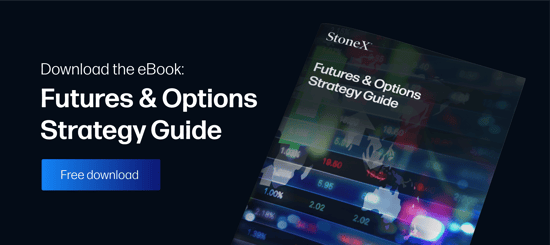A vertical spread is an options strategy in which the trader simultaneously purchases and sells multiple contracts with different strike prices. Each buy or sell, known as a “leg,” is designed to secure bullish or bearish market exposure. Bullish vertical spreads profit when prices of the underlying assets rise, and bearish spreads profit when prices fall.
Vertical spreads come in four basic types: bull call, bull put, bear call, and bear put. Let’s take a look at the nuances of these strategies and when they perform best.
Form and Function
There’s no doubt about it: Advanced options strategies can be confusing. The key to gaining a solid understanding of the hows and whys is to take things one step at a time.
At its core, a vertical spread involves the simultaneous purchase and sale of call-and-put contracts. When traders buy a call or put, they pay a premium for the contract, and when a call or put is sold or “written,” a premium is received for the contract. Thus, opening vertical spreads will initially impact the trading account in one of two ways:
- Debit: A net premium deficit occurs when the cost of the purchased contract exceeds proceeds from the written contract.
- Credit: A net premium gain occurs when proceeds from the written contract exceed the cost of the purchased contract.
The Four Types of Vertical Spreads
As we mentioned earlier, there are four types of vertical spreads. Here’s a breakdown of each kind and when it may be time to execute the strategy. For each of the following vertical spread types, all contracts are purchased and written in the same asset with the same expiration date
Bull Call Spread
A bull call spread involves buying a call option while selling a second call option at a higher strike price. Executing the bull call creates a net premium cost, so it is a debit spread:
- Maximum profit is equal to the difference in the call strikes minus the premium.
- Maximum loss is the paid premium.
Bull call spreads function well in volatile markets when call premiums are more expensive. Putting a bull call in play is plausible when a modest rise in asset pricing is anticipated.
Bear Call Spread
The bear call spread involves selling a call option while purchasing another call with a higher strike price. A bear call spread creates a net premium gain, so it is a credit spread:
- Maximum profit is the net premium received for opening the position.
- Maximum loss is the difference in call strikes minus the net premium.
Bear call spreads are ideal for volatile markets that are expected to decline modestly. Given the heightened volatility, significant up-front revenue may be garnered because premiums are typically more expensive.
Bull Put Spread
The bull put vertical spread is executed by selling a put option while purchasing a second put with a lower strike price. Executing the bull put creates a net premium gain, making it a credit spread:
- Maximum profit is the net premium received.
- Maximum loss is the difference between the strikes minus the net premium.
Bull put spreads work well for rotating, consolidating, or range-bound markets. If prices move sideways through expiry, the contract is likely to close within the established call/put range.
Bear Put Spread
To open a bear put spread, a put option is bought while another put option is sold at a lower strike price. The bear put strategy features an up-front cost, so it is classified as a debit spread:
- Maximum gain is equivalent to the difference in put strikes minus the net premium paid.
- Maximum loss is the net premium paid for the position.
Bear put spreads work well in markets that are expected to fall. Additionally, this strategy is viable during periods of stagnant or rising volatility.
Are You Ready to Cash in with the Vertical Spread?
On the surface, executing a vertical spread can be daunting. However, it is much like any other trade. All you need is a bullish or bearish bias, a grasp on market volatility, and specific risk versus reward objectives. Once these elements are in place, physically placing the trade is routine.
To learn more about what options trading can do for you, schedule your free consultation with a certified StoneX broker today.



